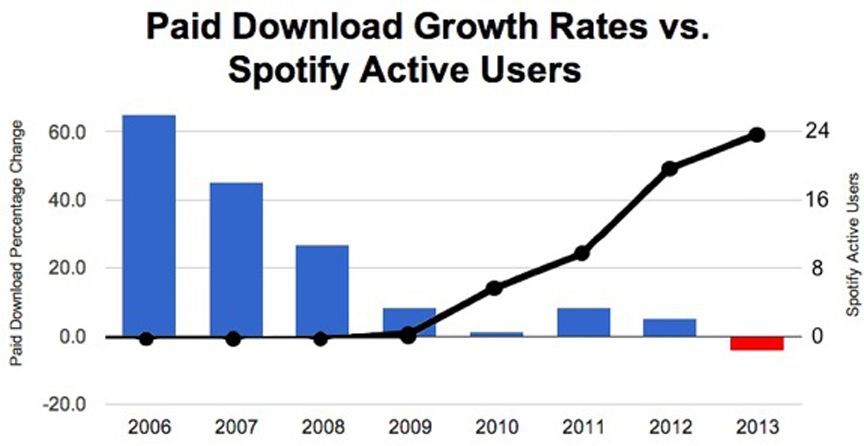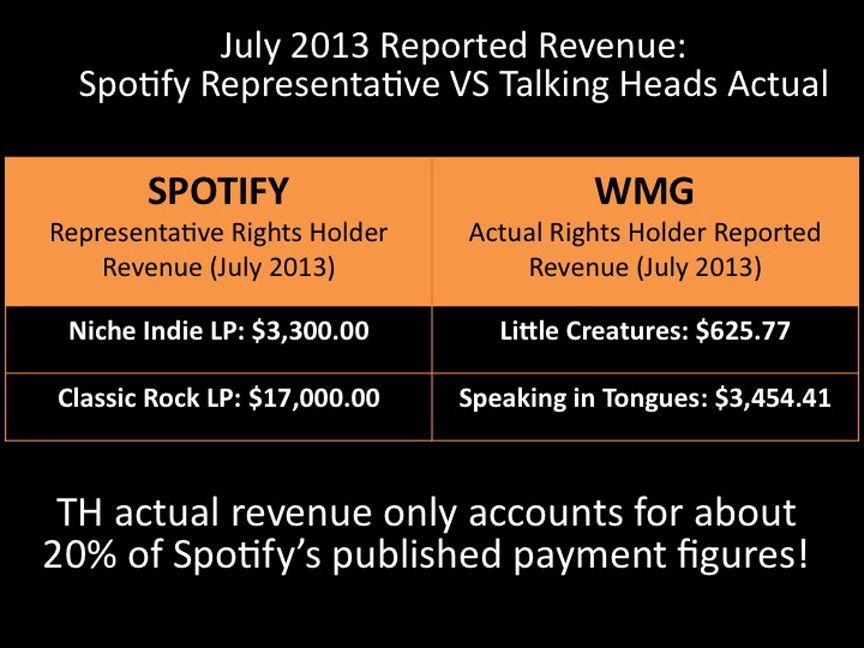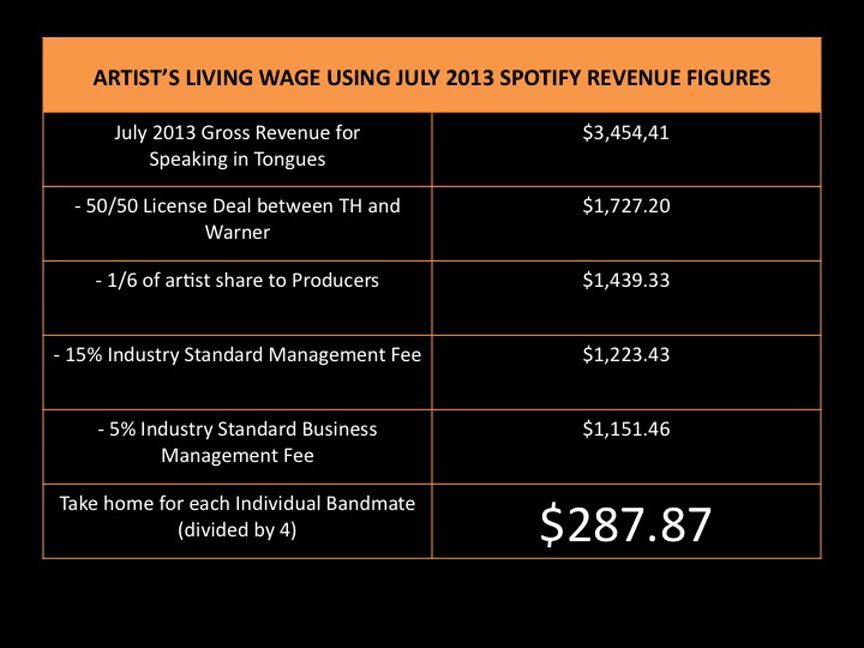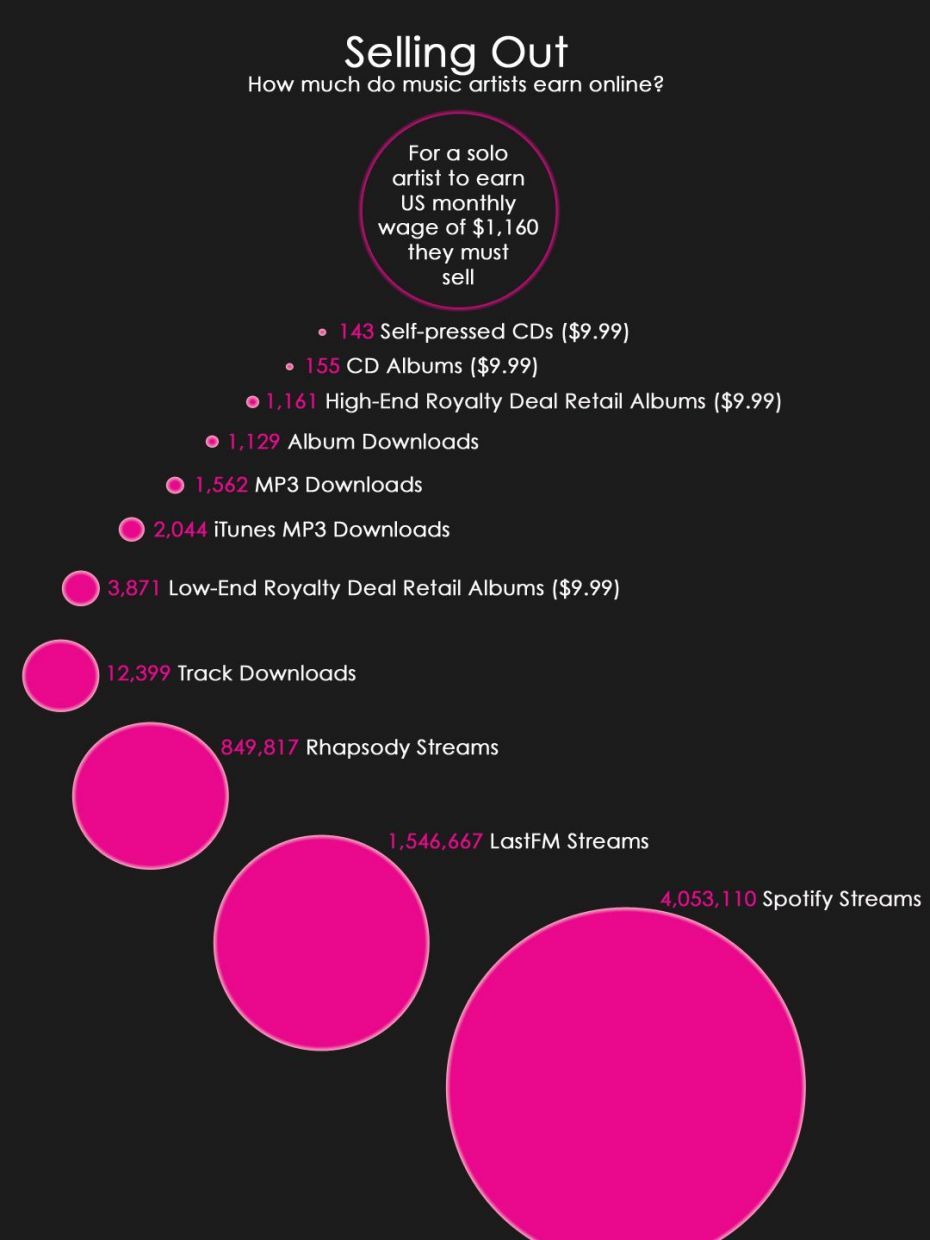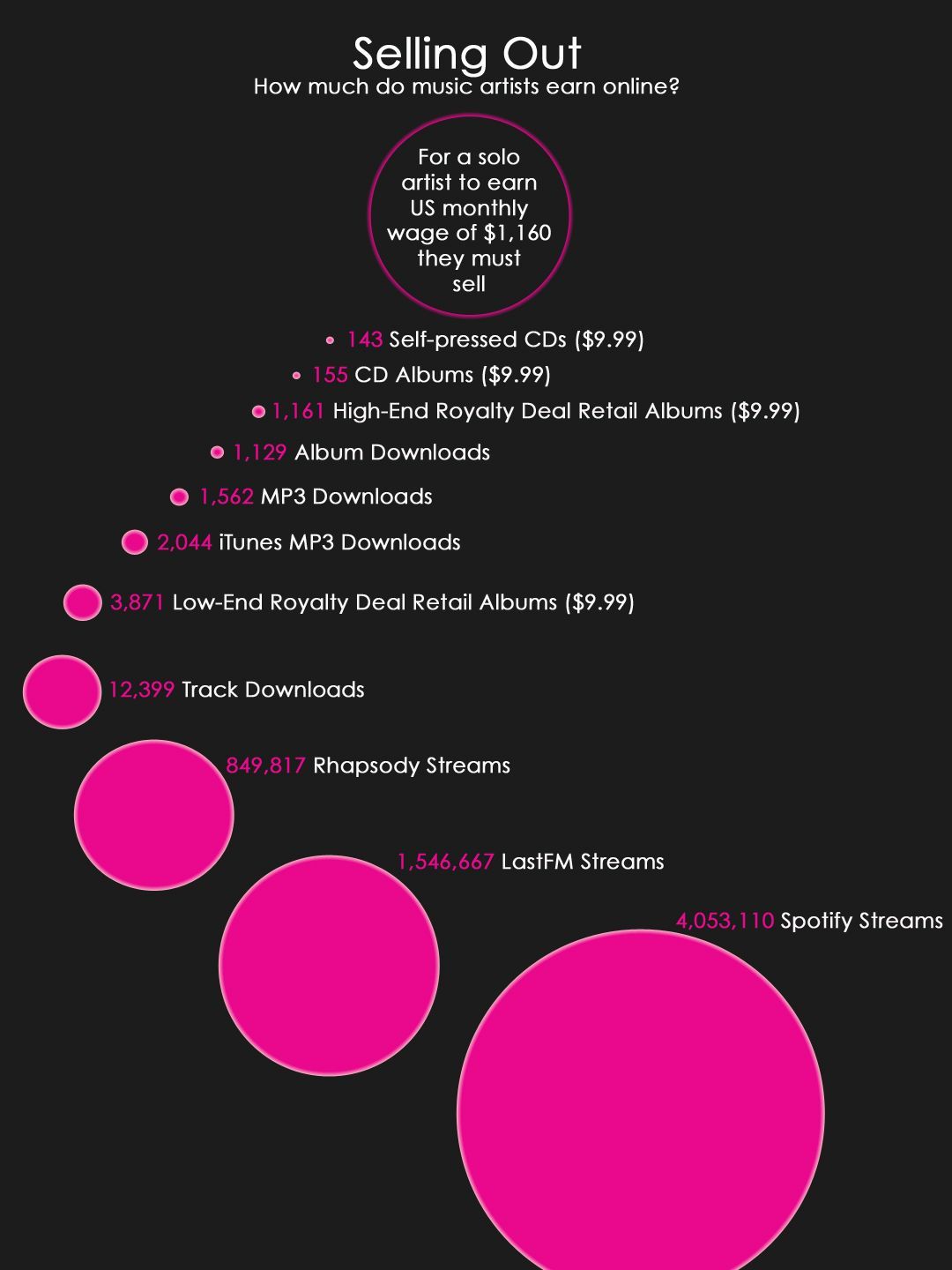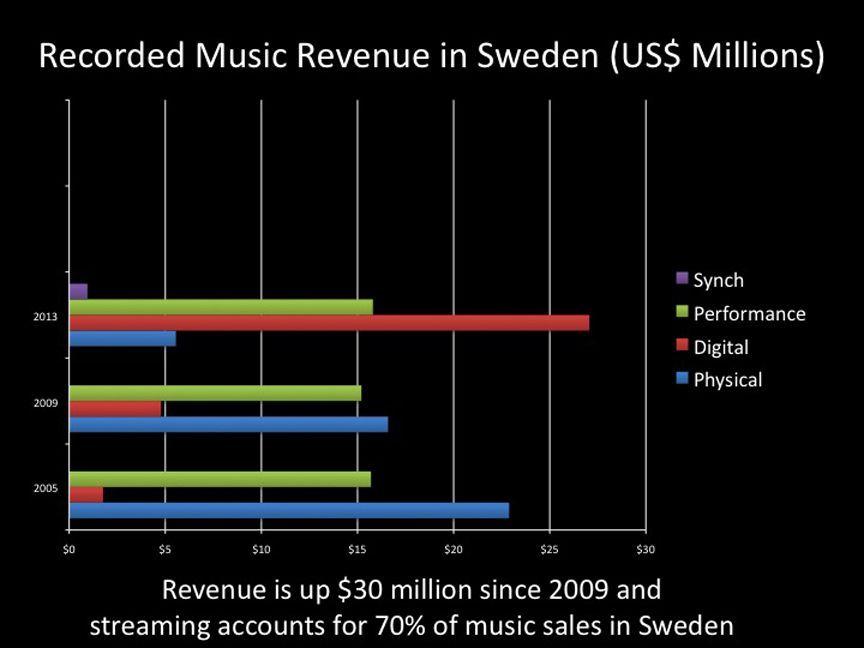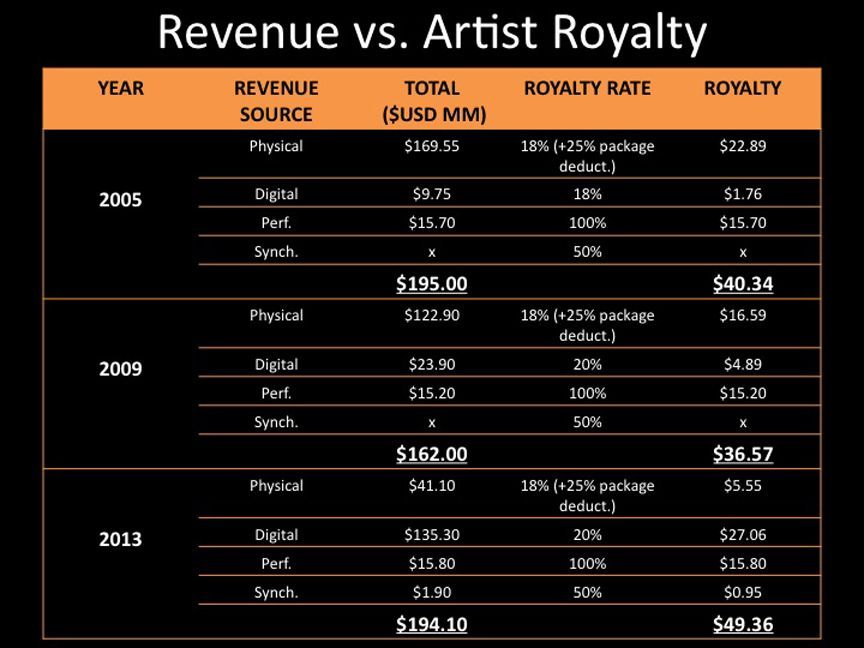GENTLY DOWN THE STREAM—AN AMSTERDAM DISCUSSION ABOUT MUSIC STREAMING (OCT. 19, 2014)
| December 22, 2014
In connection with the Dutch release of my book, How Music Works, and the Dance music festival in Amsterdam (which is about electronic dance music, not choreography), I did a discussion about the impact of streaming music with Michel Lambot, one of the founders of PIAS (a consortium that helps distribute a lot of indie labels in Europe, as well as providing a lot of services for artists). It was presented by the John Adams Institute (named after the president, not the composer). Dan Hassler-Forest, who teaches at the local University of Amsterdam, was the moderator. As you can see it’s been a while since this talk happened; I wanted to do some further research and fact checking before posting this.
I began by presenting my personal take on the likely financial future faced by musical artists (as composers and musicians are referred to in the business). I’m concerned that as streaming and subscription models become the dominant way we consume music (not just music, but soon all movies, books, television, video games, journalism—almost any creative content you can name), the amount of income from those services that trickles down to the content creators might not be enough for them to live on. The knock on effect as revenue sources from ye olde media sources dries up will be considerable. Content creators will be forced to seek other avenues for their income beyond that derived from their recordings, books, movies, you name it. More on those avenues of potential income later… as it’s already happening.
I’ve written on this before. But this time I came armed with some new data, and I wanted to hear Michel’s POV—which it turns out is fairly different than mine. I have a narrow focus on this and I’m fairly skeptical of techno utopianism, so any balance from Michel would be welcome. This event wasn’t framed as a debate, but rather a talk about what is happening and the possible or probable consequences—from slightly different, though not opposing, points of view.
First the bad news
Here’s the first slide from my side of the conversation: it shows how, as of 2013 in the U.S., all other forms of music consumption except streaming are down. Streaming is up 42%, CDs are down 16% and (legal, paid for) downloads are down 11.6 % as of last July (Source: Nielsen sound scan via Digital Music News). The writing, it would seem, is on the wall.
In Sweden—the country where Spotify originated—95% of listeners now get their music via that app. It is not that high yet in the U.S., and, in the U.S. there are other competing services (Beats, Amazon Prime, Apple, You Tube and more are on the way). In the U.S., most—about 75%—of Spotify users don’t pay anything for the service or for the music they get. They put up with the ads that are supposed to cover the licensing fees and money paid to the artists and writers. For these listeners, music is—as far as they are concerned—“free.”
From the NY Times:
“The service, which started in Sweden in 2008 and is now available in 55 markets around the world, has not updated its customer numbers since March 2013, when it reported 24 million users. Six million of those pay.”
Responding to this “free” model was part of the origin story of Spotify. In Sweden, illegal downloads of music were decimating their music industry at an increasing rate, so when Daniel Ek came up with a legal version of free music that would channel some money to the labels, the labels were thrilled.
However, the income from streaming is much lower than from previous ways of consuming music. Also from the NY Times, “In 2012, streaming services and satellite radio in the United States contributed just over $1 billion in revenue to the recording industry, a 59 percent increase from the year before. Still, those numbers are small compared with the $5.6 billion from downloads and physical sales, according to figures from the Recording Industry Association of America.”
This is from 2012, but you can extrapolate and imagine where things are now two years later, based on the graph. The income from downloads and physical sales will, if the graph continues its trajectory, shrink almost to nothing, and the streaming income will rise—but not to anywhere near the $5.6 billion from downloads and sales.
Maybe in some ways this is fair. I will grant that the recording industry was bloated, especially during the CD era. Tales of excess were rampant and common. CDs were way, way overpriced… and consumers sensed that they were being gouged. So they didn’t feel all that bad when illegal sites like Napster and Pirate Bay offered music for free. Consumers justified freeloading by saying they weren’t robbing the artists (who they said were being cheated anyway), but were cheating the evil record companies.
That reaction was unfortunate—especially for musicians. I accept that a serious price adjustment was in order, and lowered income might be acceptable for many of us—but maybe not as low as zero. Which is partly why streaming was so acceptable to artists and labels in Sweden—home of Pirate Bay. Anything was better than nothing, which is where things were heading. If you are falling you’ll pretty much grab anything and be thankful for it.
Recently, there has been a pretty big blowback in reaction to the miniscule income from streaming from a number of artists, myself included. We skeptics wonder how artists—especially emerging artists—are supposed to make a living off their recordings in the future if this emerges as the only way folks consume music (especially if most folks who use the service aren’t even paying for the subscriptions!). Our a priori assumption might be incorrect. We might be making a mistake in presuming that we will be even making recordings in the future, but bear with me.
Artists and songwriters were a little slow to analyze streaming income, as first it may have been viewed as a small but nice additional income source. But now, as the cute new source of income has grown to be an omnivorous giant, the picture looks very different.
Even Taylor Swift isn’t allowing Spotify to have access to her new record! (Sadly, a lot of the coverage of her decision avoided the big issue, and painted this as a ploy by a popular artist to force her fans to pay, simply because she can. What they failed to mention is that she can because she’s not signed to one of the big labels.) She did actually ask Spotify to take her new album on a subscription (not free) basis, but they refused. So, this is not just about some grumpy old pop stars longing for the good old days; young and even successful artists are questioning this model, too. As a partial response to all this backlash, the folks of Spotify posted a graph on their website in December of 2013 that showed what artists of differing levels of success could expect to earn from their service. They picked a month, presumably at random, and showed what income various recordings might generate.
This graph gave me an idea. If I could get the streaming income figures for one of my own albums—let’s say a Talking Heads album, as those are still of interest and might get streamed more than some of my current work—then I might compare what I get from Spotify to what they claim I should be getting. Optimistically, they’d be right and I would revise my outlook accordingly. Let’s see how it looks.
I had previously asked for, and seen, some of my own Spotify data that gets sent to Warner Bros records (who control the Talking Heads recordings), but I found the data to be impenetrable; it’s totally impossible to understand—possibly intentionally but certainly conveniently so. What one as an artist wants to know is simple—for example, how much streaming revenue did record X generate over a given time period and how many streams did it take to generate that income. However, there are so many sliding scales (free listening doesn’t pay as much as subscription listening, for example) and contingencies involved that affect the calculations that getting a simple answer is all but impossible.
This audit/investigation happened about a year ago, and I began to wonder if artists are getting into a situation where the income due to them is effectively hidden. Okay, maybe not hidden, but so hard to figure out that it is all but impossible to determine. That’s as bad as the bad old days of simply getting cheated.
Given this complexity and opaqueness, I then wondered if it would be at all possible to limit my inquiry and find out what just one or two quite successful TH records generated, for the exact same month Spotify used as an example in their graph? Could I see if their estimate of what TH should be earning is accurate or not (presuming, of course, a TH record fits one of their categories)? The only way to do that would be to crunch the mass of inscrutable figures and see if one could simplify it—following their format and for the exact same time period.
As luck would have it, around this time my business managers were doing one of their periodic audits of Warner Bros. accounts. These audits are not litigious, aggressive or adversarial—Warner doesn’t dispute them usually. It’s part of doing business. But even so, the audits usually do turn up enough unpaid income to justify the costs of the audit and the accounting. You can see that there is a gamble involved. An emerging band would not be able to take the risk of auditing their company, as the amounts they might uncover wouldn’t likely be high enough to pay for the cost of the search.
My manager, David Whitehead, wonders, “As for traditional artist protections, can you imagine trying to audit streaming? What good will contractual audit rights will be?”
Anyway, I suggested that while they were digging, the Warner folks and my own business folks might try and simplify the streaming income data, maybe even going so far as to try and fit my income figures into the same dates and format as the Spotify graph—in order to make a fair comparison. That initial request to Warner was made just over six months ago. The figures (in the appropriate format) came in a few weeks before my talk with Michel and here are the results. On the left are amounts Spotify estimated one might receive from a Niche Indie LP in one month and also from a Classic Rock LP. I picked two Talking Heads LPs that I felt might fall into those same categories.
It’s pretty damning, and it’s obvious that my (actually Warner’s) income is about 20% of what Spotify claims I should be getting. That’s a big difference. I allow that the record business was bloated, the fat should be cut off, but that’s a big drop. Even allowing for the vagaries of their musical genre descriptions—it’s pretty sad.
In addition, the bottom line amounts shown above get further subdivided. Like many other artists, I am not the primary rights holder on many of my recordings. Neither myself, nor the rest of the band receive all of that streaming income. The largest chunk goes to the rights holder. In the case of those recordings that’s the Warner Music Group. (If you, as an artist, own your masters or license them, you’re in better shape than I am with that material.) Though some record companies take more, Warner views streaming as a license (which it is, no one is buying anything) and therefore they take (only) half. (FYI I’m not factoring in writing and publishing shares—not every musician writes all or part of their own material, as I do, but that does earn me additional income. This is just about income from recordings).
After those copyright owners take their share (50% minimum), the producer gets a cut, the manager might take a percentage (15% usually), as well as the accountant (5% might be typical). Then, finally what remains is sometimes split evenly among band members. (Not every group or artist does this, but many do.) Here then, is typically what’s left for an individual to live on:
Almost $300. Okay, to be fair that’s just for one record and for one month. One might assume there would be more records generating more income, and multiply that by 12 months a year. However, that was maybe our largest selling record, and not many artists’ careers don’t have ups and downs. From this record the artist makes about $3.5k a year, so one would need to have four equally successful records to generate a living wage. Not impossible, but doesn’t happen too often.
To be fair, the divvying up of the Spotify income shown on the graph above is not Spotify’s fault. If an artist owned their masters and dealt directly with these services, they’d stand to make twice as much. Still not a living, but better.
From Information is Beautiful, here is a re-make of David McCandless' nice chart that shows how much one has to sell in various formats to earn what you would working a minimum wage job.
The streaming income from the successful Talking Heads record I picked is, I admit, not nothing—but it’s hardly enough to be what one might call financially comfortable. For an emerging act, the figures drop significantly. That is what concerns me; I’m solvent, thank you. There’s no way an even fairly successful emerging act will be able to make a living off income from their recordings. I’m not talking about obscure acts that come and go—rather, acts that have been around for years, are perceived of as successful and are well-known, that still have trouble living in what might be referred to as the middle class income bracket. (Grizzly Bear famously admitted as much in a New York magazine article.)
My manager, David Whitehead again: “There seems to be 3 sets of artists, those that keep their rights and do it themselves, those that partner with an indie label and do joint ventures or licensing deals, and those that sign to record companies outright. If streaming reduces the income flow and by consequence defeats the purpose of trying to putout recordings yourself, it begins to reverse the old tenet of do it yourself, take the risk, and enjoy the return by making more per unit.
Granted if you do it yourself you get 100% of streaming income which is better than 50%, but only if it ultimately scales up. Most artists still do deals with record companies. Is there evidence that label funding by way of advances to cover recording costs and something to live off, etc. are drying up?
And, as we know, in return for signing to a label the artist now usually has to give away other rights—be it a piece of touring, merch, etc. Most acts are unrecouped; I would estimate between 75 -85% of acts are unrecouped. On top of that, the label gets equity in the new 'model’. [The big labels are investors in Spotify.]"
I write most of my own material, which makes a difference. But think of all the artists who don’t: Frank Sinatra, almost all jazz artists, almost all classical artists, Rihanna, One Direction, Miley Cyrus and Beyonce. They won’t be getting that income.
For many acts income from recordings is only one part of how they derive an income—there are live shows, T shirts, and for some, advertising and movie licensing and maybe a sponsorship by a beverage or tech company. The Medici’s of the world are not sponsoring popular music yet. It’s popular by definition—it’s not supposed to need help!
Conclusion of Part One
So, the above was my rather bleak introduction to this discussion. It seems to me that this scenario is going to be unsustainable as a way of making a living for those of us who make recordings and hope to derive some income from them. Although it’s said writers will write, dancers will dance and musicians will compose and play whether they’re paid to or not. The “free” or the “contribute to our web zine, but we don’t pay you” models are not really sustainable forms of compensating content creation going forward.
Eventually folks who hoped to make a living by composing or writing will be forced to seek other employment or other sources of income to feed themselves or their families given the plummeting compensation and the robots who have replaced them performing at the Holiday Inn lounge. Surviving musicians will look to corporate support or to live shows for income. Or to YY in China—streaming live shows on a sort of pay per view basis.
Here is a brave post from the band Pomplamoose—a band considered to have “made it “ by their fans. It shows how despite careful planning they lost almost $12k on their 28 day tour. It’s clear they love being a band and performing, but one can’t go on and raise kids losing money.
To me, this all seems like one more example of how the digital economy has concentrated wealth in the hands of the few, while simultaneously allowing and encouraging poorly compensated “expression” by all. The middle class—where a modestly successful creator might be presumed to eventually find a home and a life—is gutted in this process, as it has been in so many other areas.
I’m doing okay, thank you. My app that includes banking in the sharing economy— replacing bankers with anyone with an Internet connection and a phone—has been wildly successful. It’s been a pleasure disrupting the banking industry. (It’s called Banksy. Catchy, eh?)
Part Two: A More Optimistic View
Michel has a more optimistic take on what’s happening.
First the context
To understand his perspective it might help to look at the last couple of decades of music consumption in Europe. Illegal file “sharing” really caught on here. (Sharing is in quotes, because it isn’t really sharing in the conventional sense. When I share something with someone, I tend to get to know them a little bit better.) Despite the closing of Napster and some other sites, illegal downloading is still how a whole generation gets most of their music—and eBooks, too in Holland! …or so I was told. (Pirate Bay servers were just seized, but the “free” view of music lives on.) Dan, our moderator, said most of his students don’t pay for recorded music and haven’t for years. (see rationale above) They also feel that they contribute more directly to the artists by going to their favorite artists concerts and buying some merch. One young woman had actually paid for one record—the Beyoncé record. I offered that’s because the pirate sites probably didn’t offer the videos that Beyoncé did for every song on her new record.
iTunes, now the dominant shop for buying music downloads, had massive success initially (in some territories) as they made it so easy to buy music, which then went into your playlists automatically (and a single song purchase is not too expensive). So, some consumers actually opted for that convenience and paid Apple rather than grabbing files via LimeWire or Bit Torrent. iTunes never caught on as much in Europe. But, as we saw in graph 1, those downloads are now shrinking worldwide. Hard to prove, but one would be very tempted to say streaming has cannibalized paid downloads.
Along comes streaming
As Michel pointed out, anything—such as streaming services—that could bring in some kind of income in Europe was welcome. Furthermore, he cited some data that shows that revenue to the music industries in Sweden and Norway, where Spotify dominates everything, has actually increased!
If there is indeed increased revenue from recordings, in this streaming dominated territory, then the future of recording income might not be a dire as it seems. I may have to take back everything I said.
From Michel: “What the graph above shows is that Musicians, all of them together (if they all had the same royalty rate), have seen their royalties in Sweden increase by 22% between 2005 and 2013. I suppose David this is real money isn't it?”
Michel also pointed out (and this is quite significant to a label owner such as himself) that prior to the advent of the streaming services, it was almost impossible for him to get a French or Belgian act, for example, heard in the U.S. or UK—played on radio or written about. Having been involved myself in a small label that occasionally put out recordings of French, Belgian or Portuguese acts in the U.S. and UK, I know what he’s talking about. Without a little airplay or a mention in the press, the visibility of these acts outside their home countries tended to be zero—but streaming services has, he claims, changed that. Now there are a handful of listeners, and maybe even fans, of these acts all over the world. Well, sometimes there are. Their presence has gone from zero to something—maybe not something huge, but getting beyond zero is a big first step.
Can the acts themselves and PIAS, their distributor, build on streaming exposure? Can the acts eventually get paying gigs in other countries and build a following to the extent where they can then get more gigs, maybe some radio play and other sources of income? Who knows? As Michel points out, it’s a step, and it wouldn’t have happened without the streaming services.
The NY Times recently ran a video by a guitarist who quite suddenly found himself in demand for live performances in Sweden and other parts of Europe even though he said, over and over, “I’ve never played there.” His exposure and new wide popularity was attributed to YouTube postings. He’s filling concert halls, not just small clubs filled with music geeks. He’s a performing virtuoso, and presumably his live revenue compensates for lack or revenue from recordings.
Same for Ed Sheeran, the UK “folk-soul” singer and songwriter. He said, "My music has been streamed 860 million times, which means that it's getting out to people… I'm playing sold-out gigs in South America, I've sold out arenas in Korea and south-east Asia. I don't think I'd be able to do that without Spotify. For me, Spotify is not even a necessary evil. It helps me do what I want to do."
Do these European musicians derive any significant income from that international streaming or does it all just come down to incremental exposure?
Do the acts PIAS distributes find a new audience? Yes, some do. Acts often got their music heard first by these new digital means. First Aid Kit, a Scandinavian folk duo, are now known in many countries, again thanks to these digital services.
Michel writes:
"For First Aid Kit, streaming was certainly the key to their success. We had, overthe last 12 months, a big hit in Europe with some German folks called MilkyChance. Their success started in Germany via streaming, which is when we picked up the album and released it in every territory. I can certainly find a dozen of other examples, but as we say in French—it will be the tree that hides the forest.
My point is more basic: I believe the market of selling music has been damaged in many territories where it existed, not because of streaming music, but simply because people want ubiquity and access. Which is something a neither a CD and even less so vinyl can offer them. In many places, the opportunity to hear music from outside that territory simply never existed... (I will come back on that).
So streaming is not cannibalising sales, it replaces a vacuum. What could be a good exercise is to compare the complete trend of, say, Speaking in Tongues over the last 5 years physical vs. downloads vs. streamings, and see if the growth of streaming royalties are coming at the expense of sales royalties. On the digital sales figure, they were also a bit artificially inflated. If I take my own example: I have downloaded (and paid for) numerous TH tracks while I had bought all of their vinyl. [Thank you Michel!] I will not download them again...
I have two more points I would like to highlight :
(1) There is no more shelf space [in stores] for an emerging underground act making a first album. There’s obviously some room for it in the download stores, but the strength of streaming is that you as a distributor don't have to pay to make it [visible or] available and therefore word of mouth works virally and more powerfully.
(2) It is true that streaming and downloads has dramatically increased the way music travels. But if there is no major success in a territory, it will not have a serious impact in the earnings of a musician. But there are many territories where revenues for a Western musician did not exist—Latin America, South East Asia, Africa—and the revenue pumps via Spotify and Deezer have now been started."
So, though I’m still skeptical whether mid-level and emerging artists like First Aid Kit can make a living in the long term—or even half a living based on the income from Scandinavian streaming services, Michel has convinced me that there are indeed some benefits that these services bring. They are opening doors that were previously closed. I have to temper my attitude just a little bit.
Michel suggests I compare the Speaking In Tongues streaming income with olde school income—a good point.
Lastly, he suggests that the benefit of having your music available anywhere—on your phone, at your office, on holiday—is hugely attractive to many people. I can imagine; lots of folks live off their phones.
Conclusion
Where now?
The Swedish/Scandinavian success story needs to be examined a bit. It’s often held up as the model for how streaming can generate enough income, once it saturates a market, to sustain companies and artists. I will however say I’m skeptical of business models that have to be a monopoly to be sustainable, but lets see.
(I also wonder if it’s significant that so much of the pop music in the U.S. is secretly written and/or produced by Swedes—they seem to have a knack for it, or some of them do. Were they inundated with massive amounts of free music when they were young? Did that allow them to amass a wide knowledge of pop music? Or did they intuit that only by tapping into global pop could they survive in music?)
Michel’s experiences with streaming opening some previously closed doors is heartening. That same argument was often made with Napster: “The exposure will get your music heard by folks who would never have heard it otherwise.” Jon Pareles of the Times was a big proponent of Napster in this regard. But as Roseanne Cash said recently, “Exposure, isn’t that something you die from?” Arguing for the value of uncompensated exposure, others have claimed, “What good is fair compensation if no one knows about your music?” True. But are the two necessarily related? Do we have to trade one for the other? Who set up that deal? Who said that tradeoff was inevitable? Maybe that argument favors the Lords of the Valley of Silicon, where getting other peoples stuff for free is a way of life.
Singer/songwriter/performer and now author Amanda Palmer advocates developing a closer relationship with one’s fans, and says that financial support, or some at least, can be derived that way. That if fans feel they have a relationship to an artist, they are more likely to support them monetarily. I can’t verify if all of what she’s done will work for everyone, but instinctively I absolutely agree that not being aloof and distant to folks who love what you do is simply being a good human.
Some artists, like her, have done Kickstarter campaigns to fund their recordings—sometimes that seems to work. One still has to get the music marketed in ways beyond your existing fans and the already-curious. Traditional record companies, though it is their job, are not always so good at this. I have done tours where fans had no idea I had a new record out, so just getting a recording paid for and available is no guarantee that folks, even fans, will know about it. Again, we’re talking about a recording—the fans did buy tickets and come to the show.
Some folks, like Palmer, are really good at maintaining their lists of fans and keeping in touch with them; not every musician or songwriter is as adept at that as she is. Maybe now they will have to be, but that’s a big ask… for some.
Other things to think about: Do we have too much music now? Do musicians have unrealistic expectations? Are we all spoiled and entitled? Technology has made it easier to make and distribute your own music, but does the world have too much of it now? Will streaming services separate the wheat from the chaff?
Maybe so, maybe not everything should succeed. The Internet is filled with crap (and cats). However, one hopes that some layer of middle class musicians who have fans but not hits might find a way to sustain themselves. The 30 or 40 musical stars that dominate the charts and the news are not a model for a healthy culture. But yes, some musicians should be left to seek other employment.
Back to the future
Have we musicians been living in a bubble? Are we heading back to the halcyon days before the advent of recorded music? Was it all just a passing trend? Was it better then? Will that be OK, maybe even welcome? Is it inevitable that only a handful of mega stars will be able to afford recording budgets while the rest of us are forced to make a living from performing live… or writing ad jingles? I myself grew up as a performer, so probably I will be able to squeak by—I know how to make a show (as well as create other avenues of income…I always felt I needed to take care of my business). But there are lots of musicians out there who haven’t a clue what to do on stage. You’ve seen them. They made a great record and wrote wonderful songs but have no stage presence whatsoever. Shoegazers, your days are numbered. I’ll bet a lot of electronic musicians will find it hard, too. Luckily their recording budgets are nil.
Without recordings by anyone but mega stars, how will we hear new stuff, beyond the latest from Ms. Knowles? Maybe we won’t unless we’re already fans. As in the halcyon days, we’ll have to visit the strip clubs in Atlanta to hear the latest rap innovations or drop into the club in our neighborhood to hear local bands live. I’m exaggerating a little, but really, there might, as a result, be a resurgence of regional music. That might not be so bad. Musicians, as in the days before recordings, might be supported by local fans who pay to see them play, and, if they are lucky, similar pockets of fans in other towns. Globalization and technology will have actually encouraged and enabled local in some kind of perverse turnaround.
I have picked on Spotify, perhaps unfairly. They are the leader, but they’re hardly the worse culprit for paying creators a pittance. That credit goes to Google and YouTube. You as a musician can try and get paid, but somehow they have made it the artist and rights holders responsibility to police their site! Then, if you do send a take down notice, it’s like playing whack-a-mole. They may claim they can’t police their own site, but that is bullshit—they’re making ad money off that stuff so they have no incentive to police it themselves. They’re aware of this reputation and given that 80% of their traffic is for music they have some incentive to play fair. I hear some new models are in the works.
All of the above applies not just to musicians, but also to anyone who makes anything that can be digitized—books, TV shows, movies, music, photography, games, software… and soon, code for 3D printers (physical objects!) will be faced with these same issues. We musicians are just the canaries in the coal mine. You might think we’re all spoiled entitled brats—and some of us are—but they’re coming for you next.
